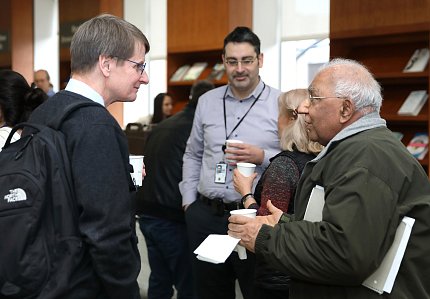Superbugs & Drugs
Pamer Lab Studies How Antibiotics Can Disrupt GI Tract

Photo: Chia-Chi Charlie Chang
Patients may, at times, have a gut feeling that antibiotics are making them ill. That’s because some of the antibiotics they’re taking to treat or prevent bacterial infections are also changing their intestinal microbiota, making them particularly susceptible to dangerous antibiotic-resistant infections.
The growing epidemic of antibiotic-resistant infections, such as Clostridium difficile (C. diff), Klebsiella pneumoniae and vancomycin-resistant enterococcus (VRE), is usually attributed to the overuse and misuse of antibiotics. Recent evidence shows that even the proper use of antibiotics may be putting people at risk for these potentially lethal superbugs.
One patient who needed antibiotics for a bacterial infection associated with cancer treatment subsequently developed recurrent C. diff infections, recounted Dr. Eric Pamer, director of the Center for Microbes, Inflammation, and Cancer at Memorial Sloan Kettering Cancer Center, during his Jan. 10 Wednesday Afternoon Lecture Series presentation in Masur Auditorium.
“C. difficile infection represents an amazing example of how the normal microbiome provides resistance against infection,” said Pamer, “and how the antibiotic treatment that’s commonplace in hospitals renders patients highly susceptible.”
The goal, then, is to re-establish the GI tract’s natural resistance against these antibiotic-resistant bacteria by restoring the healthy, diverse microbes that comprise the microbiota. One treatment option is fecal transplant, a procedure that makes some people squeamish.
“Many people recoil from the process of having feces from another individual administered to them—whether you’re a physician doing it or a patient receiving it,” said Pamer. “[There are efforts] to try to get beyond transplantation of feces and potentially identify the specific organisms that are in the microbiota that confer resistance to these various pathogens.”

Photo: Chia-Chi Charlie Chang
At MSKCC, Pamer and his colleagues study the microbiota of patients undergoing cancer treatment. Chemotherapy and radiation take a severe toll on the immune system; the highest rates of infection are seen in patients undergoing hematopoietic stem cell transplant. Many cancer patients receive broad-spectrum antibiotics as prophylaxis or to fight infections they developed during treatment.
“I think we increasingly recognize that the broad-spectrum antibiotics that we recommend profoundly affect the commensal microbiota, in essence leaving the patient with an open wound,” said Pamer, enabling such pathogens as VRE to thrive in the gut. Closing the “wound” would require re-establishing a microbiome that confers resistance to infection.
Pamer’s research could have a profound impact on preventing hospital-acquired superbugs, a leading cause of bloodstream infection. The ability to identify patients at high risk for these infections could dramatically reduce transmission of these organisms in health-care settings.
Curiously, many of Pamer’s patients who became colonized with vancomycin-resistant enterococcus had been given an antibiotic other than vancomycin.
“We now know the emergence of many of these hospital pathogens that we’re combating in our immune-compromised patients and our post-surgical patients actually result from the destruction of anaerobic bacteria in the colon,” he said, “which enables these bacteria to expand and become dominating species in these individuals. The loss of anaerobic species almost always correlates with the administration of antibiotics.”
Pamer and his colleagues Dr. Ying Taur and Dr. Joao Xavier recently received an NIAID grant to study how changes in the microbiota’s composition stimulate the emergence of antibiotic-resistant organisms. We were a good fit for this study, said Pamer, because “from a medical perspective, we have the most intensely characterized humans on the planet.” The MSKCC group has retrieved vast, detailed data from patients’ electronic medical records during their multi-week hospital stays and have obtained and sequenced daily fecal samples that show how bacteria expand in the gut during and after antibiotic regimens.
But Pamer and his colleagues wanted to move beyond feces, so they’ve been culturing and sequencing gut bacteria that confer resistance or susceptibility to different pathogens. Now, instead of using fecal samples, he said, “we’re able to assemble a handful of organisms that provide resistance to VRE.”
Clostridium scindens, an obligate anaerobe that converts primary to secondary bile salts, provides a high level of protection against C. diff. On the other hand, certain strains of Blautia producta highly inhibit growth of VRE and other gram-positive organisms but have no effect on C. diff or gram-negative bacteria such as Klebsiella.
Pamer’s lab currently is studying organisms that might resist these gram-negative rods. Recent studies identified 4 bacterial species that, upon addition to cecal contents of an ampicillin-treated mouse in an ex-vivo culture, completely inhibit growth of Klebsiella.

Photo: Chia-Chi Charlie Chang
Ongoing studies suggest that a low pH and the presence of short-chain fatty acids can inhibit Klebsiella growth.
“If we know someone’s GI tract doesn’t have secondary bile salts or short-chain fatty acids, we know the patient is extremely vulnerable to hospital-acquired infection,” said Pamer.
In a recent cohort of 94 bone marrow transplant patients, Pamer said, there was 8 percent transplant-related mortality (generally attributed to infection or graft-versus-host disease) over 3 years in patients with a highly diverse intestinal microbiota. In contrast, patients who lost diversity and anaerobic bacteria in the gut had 52 percent transplant-related mortality.
“We’re hopefully moving into an era where more and more of us will be identifying specific microbial combinations that can be re-administered to patients after they undergo extreme medical therapies, such as stem cell transplantation, but perhaps others as well,” said Pamer.
Prescribing antibiotics may need to be followed by implantation, in one form or another, of a microbiota that can protect vulnerable patients from these pathogens.
